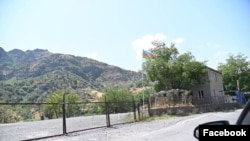Armenia’s National Security Service (NSS) said the measures were put in place at midnight on November 15.
Azerbaijan first took control of portions of a strategic road in Armenia’s Syunik province, including the Kapan-Chakaten section, after last year’s war in Nagorno-Karabakh as its troops advanced towards the Soviet-era administrative border between the two former socialist republics.
Last week Azerbaijan set up customs points at a 21-kilometer section of the road linking Kapan and Goris.
In a statement released late on Sunday the NSS said that like in the case of the Kapan-Goris road Armenia will also set up border and customs points at the Kapan-Chakaten section. It said that an alternative road for this section will be ready before the end of the year.
Azerbaijani forces set up a checkpoint on the Goris-Kapan road on September 12 to tax Iranian commercial trucks transporting cargo to and from Armenia. The move caused serious disruptions in Armenian-Iranian trade operations and raised tensions in Baku’s relations with Tehran.
From November 11 Azerbaijan also announced border controls and customs checks for all Armenian traffic, effectively barring Armenian drivers from using the road.
At a cabinet meeting in Yerevan the same day Armenian Prime Minister Nikol Pashinian said that continuing to use the Baku-controlled road section would mean agreeing to a “corridor logic” advanced by Azerbaijan. He suggested that Baku imposed the border checks because of Yerevan’s refusal to agree to a special transport corridor that would connect Azerbaijan to its Nakhichevan exclave via the portion of Syunik bordering Iran.
All traffic from the relevant road section thereafter was redirected to an alternative road bypassing the border area.
The 70-kilometer bypass road has been mostly rebuilt in recent months. Pashinian acknowledged that it is still not convenient enough for heavy trucks and needs further upgrades.
Issues related to the use of roads come amid another military escalation between Armenia and Azerbaijan. Yerevan and Baku accused each other of attempting to make advancements on the ground at different contested sections of the volatile border. Azerbaijan also accused ethnic Armenian forces in Nagorno-Karabakh of firing at its military positions.
An Armenian man in Nagorno-Karabakh was detained by Russian peacekeepers and handed over to local ethnic Armenian authorities after allegedly throwing an explosive device at Azerbaijani soldiers at a checkpoint along a Russian-controlled corridor linking Stepanakert with Armenia.
Authorities in Baku said three Azerbaijani soldiers were wounded in the incident that took place near the town of Shushi (Susa) and led to a temporary closure of the vital supply route for Nagorno-Karabakh’s Armenians. Baku described the incident as a “terrorist act.”
De facto Armenian authorities in Stepanakert, for their part, said that a joint investigation with Russian peacekeepers was under way to establish the circumstances of the November 13 incident. But they added that their preliminary findings suggested that the person who threw the explosive device was responding to “provocative actions” by Azerbaijani soldiers. They also refuted Baku's claims of casualties, insisting that no one was hurt by the explosion.
Armenia and Azerbaijan fought a 44-day war over Nagorno-Karabakh last fall. The hostilities in which nearly 7,000 people were killed were halted due to a Russia-brokered ceasefire agreement signed on November 9, 2020, that granted Azerbaijan control of parts of Nagorno-Karabakh as well as adjacent territories that had been controlled by Armenians for nearly three decades. About 2,000 Russian peacekeepers were deployed in the region under the terms of the ceasefire agreement.




